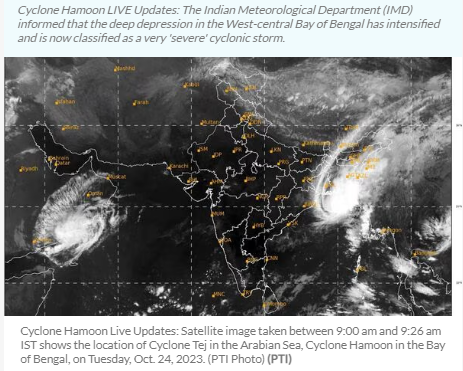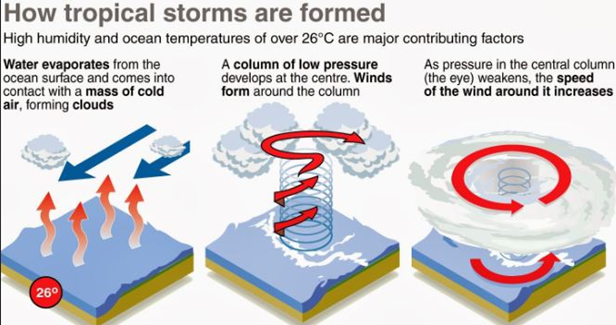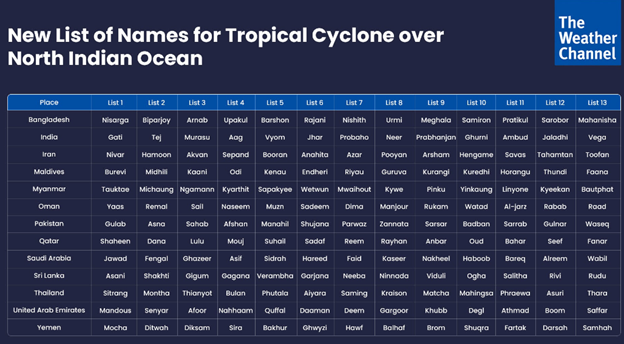Bay of Bengal Deep Depression Becomes Cyclone ‘Hamoon’
Relevance
- GS Paper 1 Important Geophysical Phenomena such as earthquakes, Tsunami, Volcanic activity, cyclone etc.
- Tags: #CycloneHamoon #IMD #EditorialAnalysis #UPSC #UPSCMains2024
Why in the News?
A deep depression over the Bay of Bengal has developed into Cyclone ‘Hamoon,’ according to the India Meteorological Department (IMD). However, it is expected to have minimal impact on the Indian coast, and the name ‘Hamoon’ was given by Iran.
What is Cyclone?
- A cyclone is a large-scale weather system characterized by strong winds, low pressure at its center, and rotating wind patterns. It can bring heavy rainfall, storm surges, and destructive winds.
How Cyclones are formed?
Warm Ocean Water
- Cyclones, also known as hurricanes or typhoons in different regions, form over warm ocean waters, typically when the sea surface temperature exceeds 26 degrees Celsius.
- Warm water acts as the primary energy source for cyclone formation.
Coriolis Effect
- As air rises above the warm ocean, it starts to spin due to the Earth’s rotation.
- In the Northern Hemisphere, this rotation is counterclockwise, while in the Southern Hemisphere, it is clockwise.
- This effect is known as the Coriolis force.
Low-Pressure Center
- The spinning air creates a low-pressure center, which draws in more moist and warm air from the ocean’s surface.
- This process intensifies the cyclone.
Condensation and Heat Release
- As the warm, moist air rises, it cools and condenses, releasing latent heat.
- This heat release further warms the air, causing it to rise even faster.
- This is a critical factor in cyclone intensification.
Development of Eye and Eyewall
- A well-defined center called the “eye” forms in the center of the storm, surrounded by a ring of powerful thunderstorms known as the “eyewall.”
- The eye is a relatively calm region with sinking air, surrounding the eye is the “eyewall,” where the strongest winds and heaviest rainfall occur.
Growth and Organization
- The cyclone continues to draw energy from the warm ocean water, and its wind speeds increase.
- The storm also starts to organize with distinct spiral rainbands surrounding the eye.
Landfall or Dissipation
- Cyclones can either make landfall, causing significant damage, or dissipate as they move over cooler waters or encounter unfavorable atmospheric conditions.
Cyclone Categories
Cyclones are categorized based on their wind speeds.
- In the Atlantic and Eastern Pacific, they are classified as tropical depressions, tropical storms, and hurricanes.
- In the Western Pacific, they are called typhoons.
- In India, we called they Cyclone.
- In Australia, they are called Willy-Willy.
Cyclone Forecasting Advancements in India
Doppler Weather Radars (DWRs)
- India’s cyclone forecasting has significantly improved with a network of 12 Doppler weather radars (DWRs) along its coastline, covering from Kolkata to Mumbai.
- These radars use radio waves to measure the size and speed of water droplets in the atmosphere, enabling real-time tracking of storms.
- DWRs can detect potential storms at least four to five days in advance, providing valuable lead time for preparedness.
International Collaborations
- The India Meteorological Department (IMD) collaborates with global networks like the Japan Meteorological Agency, the U.S. National Hurricane Center, and the U.S. Central Pacific Hurricane Center.
- These partnerships facilitate the exchange of warnings and forecasts, enhancing India’s ability to monitor changes in ocean weather.
How Cyclone’s are named?
- The process of naming tropical cyclones in the north Indian Ocean began in 2004, with names proposed by 8 member countries India, Myanmar, Oman, Maldives, Bangladesh, Sri Lanka and Pakistan,
- The naming of cyclone is done by countries on rotational basis.
- Worldwide, 6 Regional Specialized Meteorological Centers (RSMCs) and five Regional Tropical Cyclone Warning Centres (TCWCs) are responsible for issuing advisories and naming tropical cyclones
- The process is coordinated by the India Meteorological Department, acting as one of the Regional Specialized Meteorological Centers (RSMCs).
- 13 member countries are covered by this naming system, including Bangladesh, India, Iran, Maldives, Myanmar, Oman, Pakistan, Qatar, Saudi Arabia, Sri Lanka, Thailand, the United Arab Emirates, and Yemen.
Criteria for Naming
- Names must be politically, religiously, culturally, and gender-neutral.
- They should not offend any group, be overly harsh, or be too long.
- The maximum name length is 8 letters.
- Each name comes with a pronunciation guide and voiceover.
- Names are never repeated, and once used, they are retired from future use.
- New names are periodically introduced, and changes can be made if reasonable objections arise in the future.
Impact of Cyclones
Negative Impact of Cyclone
Destructive Winds
- Cyclones bring strong winds that can reach extreme speeds, causing widespread damage to infrastructure, homes, and vegetation.
- High winds also lead to power outages, disrupting daily life and critical services.
Heavy Rainfall and Flooding
- Cyclones unleash torrential rainfall, resulting in flooding of low-lying areas, rivers, and coastal regions.
- Flooding can damage crops, contaminate water sources, and displace communities.
Storm Surges
- Cyclones create storm surges, leading to a rapid rise in sea levels along the coast.
- These surges can inundate coastal areas, causing severe coastal erosion and destruction.
Loss of Lives and Injuries
- Cyclones can lead to casualties and injuries due to collapsing buildings, flying debris, and flood-related incidents.
- Disruption of essential services can hinder timely medical assistance.
Economic Impact
- Cyclones have a significant economic impact, causing damage to agriculture, fisheries, infrastructure, and tourism.
- Recovery and reconstruction efforts require substantial financial resources.
Positive Impacts of Cyclone
Heat Balance – Tropical cyclones help maintain the global heat balance by moving warm tropical air away from the equator, towards the poles. Without them, the tropics would get hotter and the poles a lot colder.
Crisis Awareness and Preparedness
- Cyclones raise awareness about disaster preparedness, leading to the development of early warning systems and disaster management plans.
- Communities become more resilient to future disasters.
Cyclones pose a significant threat to India’s coastal regions, necessitating a comprehensive approach to disaster preparedness and mitigation. The government’s efforts in early warning systems, infrastructure development, and community resilience building are crucial steps in reducing cyclone-related impacts. However, continued investment in disaster management, climate adaptation strategies, and sustainable coastal development is essential to safeguard India’s vulnerable communities from the increasing intensity and frequency of cyclones in the face of climate change.
Source: Livemint, Indian Express, The hindu
Mains Question
Discuss the factors contributing to the formation and intensification of tropical cyclones in the North Indian Ocean. How do these cyclones impact the coastal regions and ecosystems?






